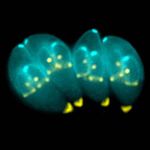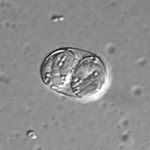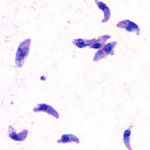Toxoplasma gondii
Jump to navigation
Jump to search
- Major pathogenic species called Toxoplasma gondii
- Causes disease in a wide range of animal species including humans
- Important cause of abortion in sheep
- Zoonotic
- Can cause abortion
- Can cause congenitally aquired defects
- Forms a sporulated oocyst which is only 10μm
- Contains 2 sporocysts with 4 sporozoites
- Transmission through ingesting the intermediate host or via the faecal-oral route
Life Cycle
- Complex
- Usually indirect
- Referred to as facultatively heteroxenous
- Intermediate host is not essential for completion of the life cycle
- Gametogony (sexual stage) is host specific for felids
- Any warm blooded animal can act as a facultative intermediate host
- Asexual reproduction occurs in the intermediate host forming tissue cysts
- Intermediate host swallows sporulated oocysts or tissue cysts
- Can be transferred between intermediate hosts by carnivorism
- Cats
- Sporulation occurs in 2-3 days
- Cats either swallow infective (sporulated) oocysts where Toxoplasma gondii has a prepatent period of 3 weeks
- Or eat the tissues of an infected intermediate host where Toxoplasma gondii has a prepatent period of 3-10 days
- Self-limiting infection
- Oocysts are shed for 1-2 weeks
- Shedding can occur later if immunity wanes or cat is immuno-compromised
- Intermediate host
- 3 sources of infection
- Oocysts from environment contaminated by cat faeces
- Eating cysts in tissues of other infected hosts through carnivorism or undercooked meat
- Transplacental transmission in some host species during the acute phase of infection
- 3 sources of infection
- Acute phase of infection
- After infection of the intermediate host the organism undergoes a phase of rapid division and dissemination throughout the body
- Parasite enters cell and asexual reproduction occurs by endodyogeny (budding) producing 8-16 tachyzoites
- Tachyzoites are released when host cell bursts
- Haematogenous spread as more cells are infected
- Infection continues until the animal develops immunity (around 2 weeks) at which point the infection enters the chronic phase
- After infection of the intermediate host the organism undergoes a phase of rapid division and dissemination throughout the body
- Chronic phase of infection
- Occurs once the host's immune response has become effective
- Groups of slow growing intracellular bradyzoites become walled off forming infective cysts
- Bradyzoites inside cysts are protected from the host immune response whereas extracellular tachyzoites are killed
- Cysts remain viable for months to years and are particularly numerous in muscle and nervous tissue
- If immunity is suppressed the infection can revert to the acute form
- Occurs once the host's immune response has become effective
- Meat animals
- Significant proportion of cattle, sheep, pigs and rabbits can tissue cysts
Pathogenesis
- Cattle and horses
- Sometimes infectious causing opthalmitis
- Dogs
- Complication of canine distemper
- Causes pneumonia and encephalitis
- Toxoplasma can cause acute interstitial pancreatitis in systemic toxoplasmosis
- Toxoplasma gondii causes myositis
- Humans
- Mostly asymptomatic
- Virulent strains cause flu-like symptoms, malaise and/or lymphadenopathy
- In immunodeficient patients, disease can even be caused by avirulent strains
- If a non-immune women is infected during pregnancy, abortion or the birth of a congenitally infected child can result
- E.g. Hydrocephalus, opthalmitis, mental retardation
- Human
- 30% seropositive in UK, 70% seropositive in France
Prevention
- Avoid oocyst ingestion
- Wash potentially contaminated raw food thoroughly
- Wash hands after gardening or handling cats and especially before eating
- Clean out cat litter trays every day before oocysts sporulate
- Avoid ingestion of tissue cysts
- Do not eat undercooked meat
- Wash hands after handling raw meat
- Take care when lambing or dealing with sheep abortions and stillbirths
- Pregnant women should avoid lambing altogether
- Avoid oocyst ingestion




